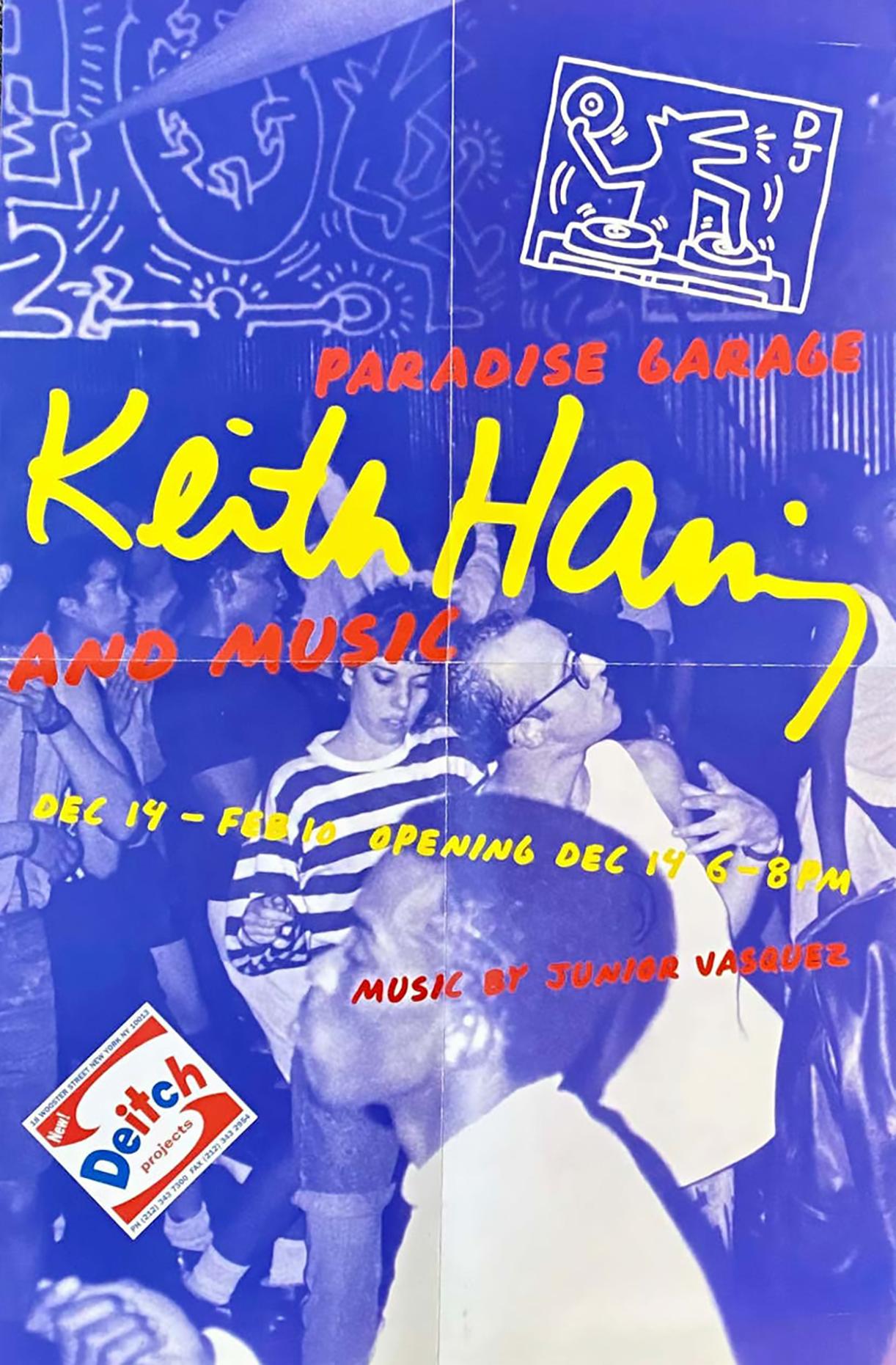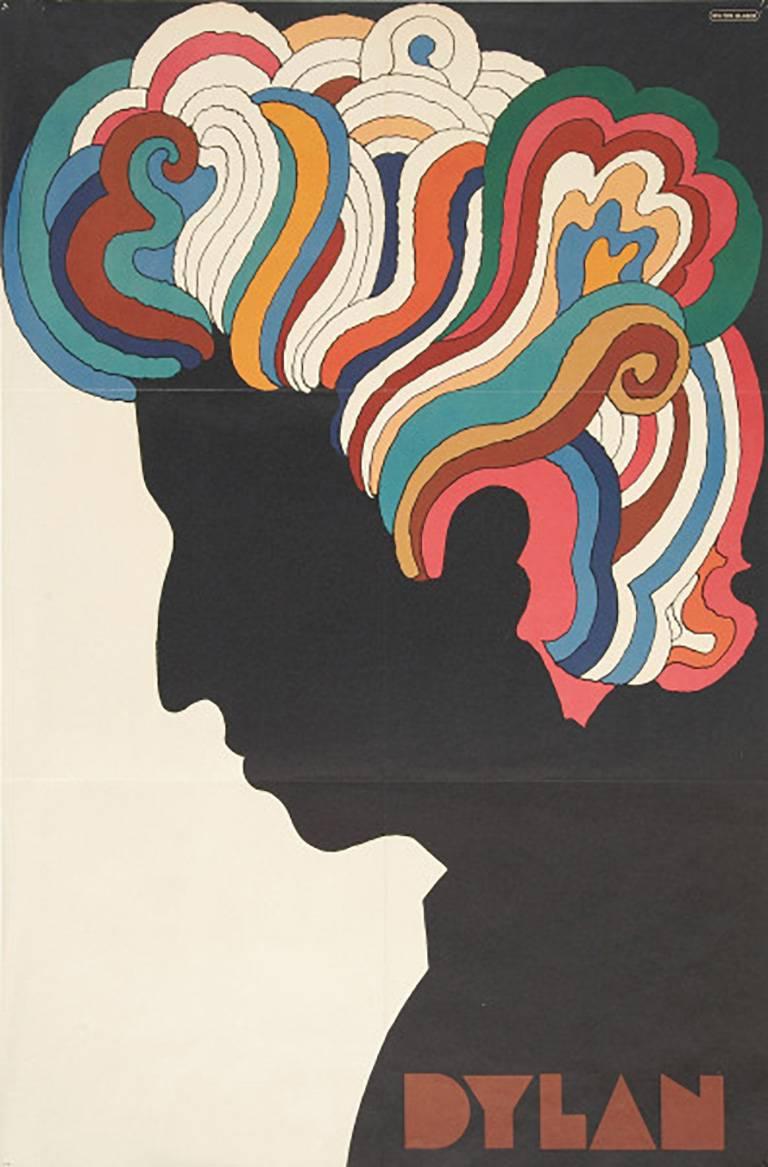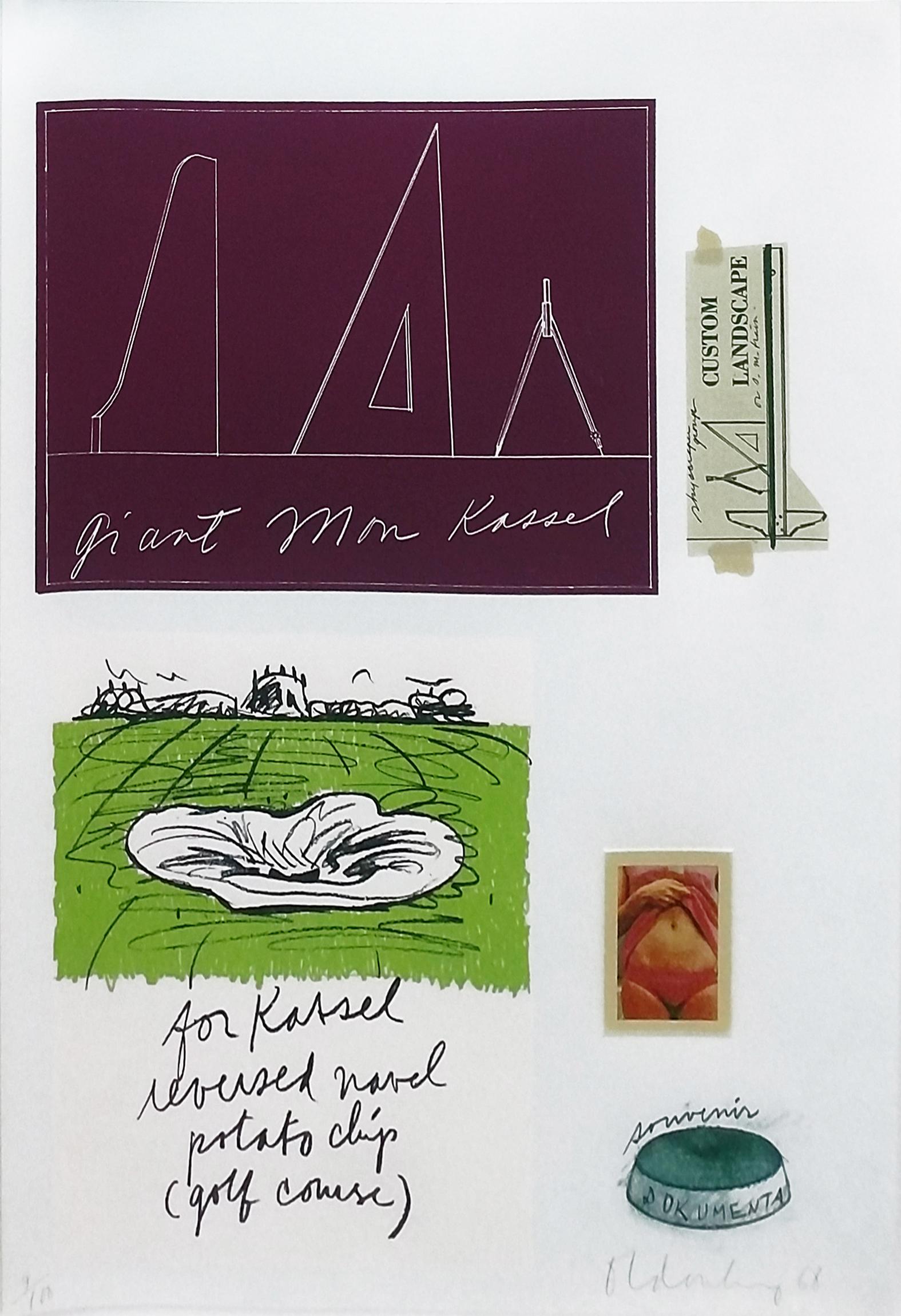James RosenquistLarge American Pop Art Color Abstract Lithograph "Black Tie" James Rosenquist 1977
1977
About the Item
- Creator:James Rosenquist (1933, American)
- Creation Year:1977
- Dimensions:Height: 39 in (99.06 cm)Width: 75 in (190.5 cm)
- Medium:
- Movement & Style:
- Period:
- Condition:good. piece is great. some light foxing to the mat. frame has light wear This can be shipped unframed for 65.00.
- Gallery Location:Surfside, FL
- Reference Number:1stDibs: LU3829934722
James Rosenquist
Although he insisted that he and his fellow Pop artists developed their art-making styles independently, American painter James Rosenquist belonged at the table with Andy Warhol and Roy Lichtenstein.
Known for his distinctive use of visual montage, Rosenquist produced large, vibrantly colored tableaux marked by fragmentation and overlap. He often employed familiar motifs and objects drawn from popular contemporary culture — hot dogs, lipstick tubes, American flags — which he manipulated to form disorienting compositions whose constituent elements are nearly unrecognizable.
Born in North Dakota to Swedish parents, Rosenquist was encouraged to pursue painting by his mother, who was also an artist. He studied painting for two years at the University of Minnesota, but dropped out at the age of 21 to attend the Art Students League in New York on a scholarship. A job as a billboard painter in the late 1950s set him up to pursue his signature style, which borrowed its bold graphics and remixed kitschy aesthetic from the visual vocabulary of advertising. Works like Flamingo Capsule (1983) embody his trademark visual dissonance, drawing cigarette-ad motifs into conversation with stripes from the American flag and aluminum foil wrappers.
In addition to enormous paintings, Rosenquist created drawings, prints and collages. The 2011 lithograph The Memory Continues but the Clock Disappears is a montage of melting clocks and confetti, all submerged in a pool of water. While wryly hinting at the inevitability of decay and deterioration — suggesting that life is a ticking clock — the composition also alludes to Salvador Dalí's signature motif, the defining symbol of Surrealism. Such compositions demonstrate how Rosenquist masterfully combined seemingly incongruous elements into a harmonious and poetic whole.
Find James Rosenquist art today on 1stDibs.
- ShippingRetrieving quote...Ships From: Surfside, FL
- Return PolicyA return for this item may be initiated within 3 days of delivery.
- 1970s Surrealist Pop Art Nude Angel Lithograph Print Psychedelic ColorLocated in Surfside, FLHand Signed verso D. Herbert and numbered 1 of 20. (possibly Don Herbert)Category
20th Century Pop Art Abstract Prints
MaterialsLithograph
- Joe Tilson British Pop Art Screenprint, Color Lithograph 4 Seasons 4 ElementsBy Joe TilsonLocated in Surfside, FLSilkscreen screenprint or Lithograph Hand signed and numbered. An esoteric, mystical, Kabbala inspired print with Hebrew as well as other languages. Joseph Charles Tilson RA (born 2...Category
1970s Pop Art Abstract Prints
MaterialsLithograph, Screen
- Judy Rifka Abstract Expressionist Contemporary Lithograph Hebrew 10 CommandmentBy Judy RifkaLocated in Surfside, FLJudy Rifka (American, b. 1945) 44/84 Lithograph on paper titled "Thou Shalt Not Bear False Witness against Thy Neighbor"; Depicting an abstract composition in blue, green, red and black tones with Hebrew script. Judaica interest. (I have seen this print described as a screenprint and as a lithograph) Hand signed in pencil and dated alongside an embossed pictorial blindstamp of a closed hand with one raised index finger. Solo Press. From The Ten Commandments Kenny Scharf; Joseph Nechvatal; Gretchen Bender; April Gornik; Robert Kushner; Nancy Spero; Vito Acconci; Jane Dickson; Judy Rifka; Richard Bosman and Lisa Liebmann. Judy Rifka (born 1945) is an American woman artist active since the 1970s as a painter and video artist. She works heavily in New York City's Tribeca and Lower East Side and has associated with movements coming out of the area in the 1970s and 1980s such as Colab and the East Village, Manhattan art scene. A video artist, book artist and abstract painter, Rifka is a multi-faceted artist who has worked in a variety of media in addition to her painting and printmaking. She was born in 1945 in New York City and studied art at Hunter College, the New York Studio School and the Skowhegan School of Painting and Sculpture in Maine. Rifka took part in the 1980 Times Square Show, (Organized by Collaborative Projects, Inc. in 1980 at what was once a massage parlor, with now-famous participants such as Jenny Holzer, Nan Goldin, Keith Haring, Kenny Scharf, Jean-Michel Basquiat, and Kiki Smith, the roster of the exhibition reads like a who’s who of the art world), two Whitney Museum Biennials (1975, 1983), Documenta 7, Just Another Asshole (1981), curated by Carlo McCormick and received the cover of Art in America in 1984 for her series, "Architecture," which employed the three-dimensional stretchers that she adopted in exhibitions dating to 1982; in a 1985 review in the New York Times, Vivien Raynor noted Rifka's shift to large paintings of the female nude, which also employed the three-dimensional stretchers. In a 1985 episode of Miami Vice, Bianca Jagger played a character attacked in front of Rifka's three-dimensional nude still-life, "Bacchanaal", which was on display at the Museum of Art Fort Lauderdale. Rene Ricard wrote about Rifka in his influential December 1987 Art Forum article about the iconic identity of artists from Van Gogh to Jean-Michel Basquiat and Keith Haring, The Radiant Child.The untitled acrylic painting on plywood, in the collection of the Honolulu Museum of Art, demonstrates the artist's use of plywood as a substrate for painting. Artist and writer Mark Bloch called her work "imaginative surfaces that support experimental laboratories for interferences in sensuous pigment." According to artist and curator Greg de la Haba, Judy Rifka's irregular polygons on plywood "are among the most important paintings of the decade". In 2013, Rifka's daily posts on Facebook garnered a large social media audience for her imaginative "selfies," erudite friendly comments, and widely attended solo and group exhibitions, Judy Rifka's pop art figuration is noted for its nervous line and frenetic pace. In the January 1998 issue of Art in America, Vincent Carducci echoed Masheck, “Rifka reworks the neo-classical and the pop, setting all sources in quotation for today’s art-world cognoscenti.” Rifka, along with artists like David Wojnarowicz, helped to take Pop sensibility into a milieu that incorporated politics and high art into Postmodernism; Robert Pincus-Witten stated in his 1988 essay, Corinthian Crackerjacks & Passing Go that "Rifka’s commitment to process and discovery, doctrine with Abstract Expressionist practice, is of paramount concern though there is nothing dogmatic or pious about Rifka’s use of method. Playful rapidity and delight in discovery is everywhere evident in her painting." In 2016, a large retrospective of Rifka's art was shown at the Jean-Paul Najar Foundation in Dubai. In 2017, Gregory de la Haba presented a Rifka retrospective at the Amstel Gallery in The Yard, a section of Manhattan described as "a labyrinth of small cubicles, conference rooms and small office spaces that are rented out to young entrepreneurs, professionals and hipsters". In 2019 her video Bubble Dancers New Space Ritual was selected for the International Istanbul Bienali. Alexandra Goldman Talks To Judy Rifka About Ionic Ironic: Mythos from the '80s at CORE:Club and the Inexistence of "Feminist Art" Whitehot Magazine of Contemporary Art. She was included in "50 Contemporary Women Artists", a book comprising a refined selection of current and impactful artists. The foreword is by Elizabeth Sackler of the Brooklyn Museum’s Sackler Center for Feminist Art. Additional names in the book include sculptor and carver Barbara Segal...Category
1980s Pop Art Abstract Prints
MaterialsLithograph, Screen
- Large American Pop Art Color Abstract Lithograph James Rosenquist Glass WishesBy James RosenquistLocated in Surfside, FLJames Rosenquist (1933-2017) THE GLASS WISHES (Glenn 161) Color lithograph, 1978-1986, on wove paper, hand signed, dated, titled, dedicated for Jack Martin...Category
1980s Pop Art Abstract Prints
MaterialsColor, Lithograph
- Vintage Pop Art 1997 Offset Lithograph Larry Rivers Music Poster Hamptons NYBy Larry RiversLocated in Surfside, FLLarry Rivers "The Music Festival of the Hamptons / July 18-27 1997" poster, Not hand signed. [Dimensions: 24" H x 18" W] Larry Rivers (born Yitzroch Loiza Grossberg) (1923 – 2002) was an American artist, musician, filmmaker, and occasional actor. Considered by many scholars to be the "Godfather" and "Grandfather" of Pop art, he was one of the first artists to merge non-objective, non-narrative art with narrative and objective abstraction. Rivers took up painting in 1945 and studied at the Hans Hofmann School from 1947–48. He earned a BA in art education from New York University in 1951. His work was quickly acquired by the Museum of Modern Art. A 1953 painting Washington Crossing the Delaware was damaged in fire at the museum five years later. He was a pop artist of the New York School, reproducing everyday objects of American popular culture as art. He was one of eleven New York artists featured in the opening exhibition at the Terrain Gallery in 1955 along with Paul Mommer, Leonard Baskin, Peter Grippe During the early 1960s Rivers lived in the Hotel Chelsea, notable for its artistic residents such as Bob Dylan, Janis Joplin, Leonard Cohen, Arthur C. Clarke, Dylan Thomas, Sid Vicious and multiple people associated with Andy Warhol Factory and where he brought several of his French nouveau réalistes friends like Yves Klein who wrote there in April 1961 his Manifeste de l'hôtel Chelsea, Arman, Martial Raysse, Jean Tinguely, Niki de Saint-Phalle, Christo & Jean Claude, Daniel Spoerri or Alain Jacquet, several of whom, like Rivers, left some pieces of art in the lobby of the hotel for payment of their rooms. In 1965, Rivers had his first comprehensive retrospective in five important American museums. His final work for the exhibition was The History of the Russian Revolution, which was later on extended permanent display at the Hirshhorn Museum and Sculpture Garden in Washington, DC. He spent 1967 in London collaborating with the American painter Howard Kanovitz. In 1968, Rivers traveled to Africa for a second time with Pierre Dominique Gaisseau to finish their documentary Africa and I, which was a part of the groundbreaking NBC series Experiments in Television. During this trip they narrowly escaped execution as suspected mercenaries. During the 1970s, Rivers worked closely with Diana Molinari and Michel Auder on many video tape projects, including the infamous Tits, and also worked in neon. Rivers's legs appeared in John Lennon and Yoko Ono's 1971 film Up Your Legs Forever. From 1940–1945 he worked as a jazz saxophonist in New York City, changing his name to Larry Rivers in 1940 after being introduced as "Larry Rivers and the Mudcats" at a local pub. He studied at the Juilliard School of Music in 1945–46, along with Miles Davis, with whom he remained friends until Davis's death in 1991. Larry Rivers was born in the Bronx to Samuel and Sonya Grossberg, Jewish immigrants from Ukraine. In 1945, he married Augusta Berger, and they had one son, Steven. Rivers also adopted Berger's son from a previous relationship, Joseph, and reared both children after the couple divorced. In 1949 he had his first one-man exhibition at the Jane Street Gallery in New York. This same year, he met and became friends with John Ashbery, and Kenneth Koch. In 1950 he met Frank O’Hara. This same year he took his first trip to Europe spending eight months in Paris, France, reading and writing poetry. Beginning in 1950 and continuing until Frank’s death in July of 1966, Larry Rivers and Frank O’Hara cultivated a uniquely creative friendship that produced numerous collaborations, as well as inspired paintings and poems. In 1951 Rivers’ works were shown at the Tibor de Nagy Gallery where he continued to show annually (except 1955) for about 10 years. In 1954 he had his first exhibition of sculptures at the Stable Gallery, New York. In 1955 The Museum of Modern Art acquired Washington Crossing the Delaware. This same year he won 3rd prize in the Corcoran Gallery national painting competition for “Self-Figure.” Rivers’ also painted “Double Portrait of Berdie” in 1955, which was soon purchased by the Whitney Museum. In 1957 he and Frank O’Hara began work on “Stones,” a collaborative mix of images and poetry in a series of lithograph for Tatyana Grosman company ULAE. During this time he also appeared on the television game show “The $64,000.00 Question” where along with another contestant, they both won, each receiving $32,000.00. In 1958 he again spent time in Paris and played in various jazz bands. In 1959 he painted Cedar Bar Menu...Category
1990s Pop Art Abstract Prints
MaterialsLithograph, Offset
- Vintage Modern Lithograph Poster 1960s Pop Art Mod FigureBy Richard LindnerLocated in Surfside, FLVintage 1960's Lithograph poster for Vancouver Canada art show. Richard Lindner was born in Hamburg, Germany. In 1905 the family moved to Nuremberg, where Lindners mother was owner o...Category
1960s Pop Art Abstract Prints
MaterialsLithograph
- Keith Haring Paradise Garage Exhibit Poster 'Keith Haring Jeffrey Deitch'By Keith HaringLocated in NEW YORK, NYRare vintage Keith Haring exhibition poster published on the occasion of: ‘Paradise Garage: Keith Haring and Music, December 14, 2000-February 10, 2001, Deitch Projects, 18 Wooster ...Category
1980s Pop Art Figurative Prints
MaterialsPaper, Lithograph, Offset
- Vintage Bob Dylan Souvenir Poster (Milton Glaser Bob Dylan 1960s)By Milton GlaserLocated in NEW YORK, NYOriginal 1967 Milton Glaser Fold Out Poster for Bob Dylan's Greatest Hits. Offset lithograph printed in colors 33 x 22 in (83.82 x 55.88 cm) Fold lines as issued; very good vinta...Category
1960s Pop Art Figurative Prints
MaterialsLithograph
- Robert Rauschenberg 'Core'By Robert RauschenbergLocated in New York, NYC.O.R.E. 1965 Lithograph Signed and numbered edition of 200 36 X 24 inches Robert Rauschenberg’s work reflects a methodology between the approaches of structuralism and post-...Category
21st Century and Contemporary Pop Art Abstract Prints
MaterialsLithograph
- NOTES (KASSEL)By Claes OldenburgLocated in Aventura, FLHand signed and numbered by the artist. Edition of 100. Sheet size 23 x 15 in. Framed. Artwork is in excellent condition. Certificate of Authenticity is included. All reasonable of...Category
1960s Pop Art Figurative Prints
MaterialsPaper, Lithograph
- Basquiat Gray 1980By Jean-Michel BasquiatLocated in NEW YORK, NYJean-Michel Basquiat (untitled) Gray 1980: An exceptionally rare 1980 flyer created by Basquiat for his band, GRAY. Literature: Jean-Michel Basquiat 1981: The Studio of the Street', (Deitch, Cortez, Vassell): Seeing Loud: Basquiat and Music (Buchhart, Bessières, Desmarais). Further background as follows: Basquiat illustrated & printed this work much in the manner of his well-documented, Anti-Product Cards and several other xerox collages of this period: here, Basquiat draws over a found image, then employs his famous William Burroughs style 'cut-up' technique; completing the piece by abstractly scrawling the word, 'Gray' above. RARE & not be to be passed on. Medium: Color Xerox on paper. 1980. Dimensions: 8.5 x 11 inches. Condition: Good overall vintage condition; scattered soiling marks; minor signs of handling & aging; typewriting on the reverse; minor corner bending in one or more places. Unsigned from an edition of unknown; few known to have survived. Provenance: Obtained directly from a prominent Basquiat Gray...Category
1980s Pop Art Figurative Prints
MaterialsOffset, Lithograph
- Milton Glaser San Diego Jazz Festival 1983 (Milton Glaser posters)By Milton GlaserLocated in NEW YORK, NY1980s Milton Glaser Poster Art: San Diego Jazz Festival: Vintage original Milton Glaser poster c.1983. Designed by Milton Glaser on the occasion of the San Diego Jazz Festival, a Pacific Coast event depicted with a suit-and-sandal clad bear at dusk. Several favorite Glaserisms show up here: the swirling contours, the loose cross-hatching and the saxophone. Offset lithograph poster in colors. 24x36 inches. Very good overall vintage condition with the exception of perhaps some minor signs of handling. A suit-and-sandal bear heralds this Pacific Coast event with a serenade with a beautiful sunset. Several favorite Glaserisms show up here: the swirling contours, the loose cross-hatching and the sax. Literature: Milton Glaser Posters Legendary graphic designer, illustrator, and art director Milton Glaser created some of the most recognizable iconography in America today —including the iconic I ♥ N Y logo —and countless posters and ad campaigns. Glaser changed the face of commercial art in the 1960s and ’70s, breaking with the conventions of modernism and drawing inspiration from a wide variety of art-historical and pop-cultural sources, from Art Nouveau to comic illustration...Category
1980s Pop Art Figurative Prints
MaterialsLithograph, Offset






